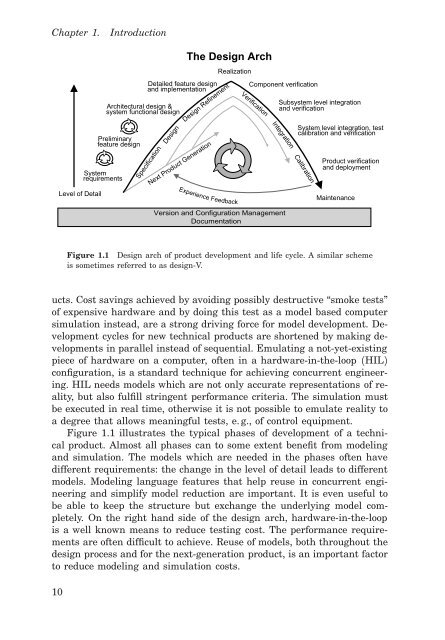Design and Implementation of Object-Oriented ... - Automatic Control
Design and Implementation of Object-Oriented ... - Automatic Control
Design and Implementation of Object-Oriented ... - Automatic Control
Create successful ePaper yourself
Turn your PDF publications into a flip-book with our unique Google optimized e-Paper software.
Chapter 1. Introduction<br />
Level <strong>of</strong> Detail<br />
System<br />
requirements<br />
Architectural design &<br />
system functional design<br />
Preliminary<br />
feature design<br />
The <strong>Design</strong> Arch<br />
Realization<br />
Detailed feature design Component verification<br />
<strong>and</strong> implementation<br />
Specification<br />
<strong>Design</strong> <strong>Design</strong> Refinement<br />
Next Product Generation<br />
Experience Feedback<br />
Verification Integration Calibration<br />
Version <strong>and</strong> Configuration Management<br />
Documentation<br />
Subsystem level integration<br />
<strong>and</strong> verification<br />
System level integration, test<br />
calibration <strong>and</strong> verification<br />
Product verification<br />
<strong>and</strong> deployment<br />
Maintenance<br />
Figure 1.1 <strong>Design</strong> arch <strong>of</strong> product development <strong>and</strong> life cycle. A similar scheme<br />
is sometimes referred to as design-V.<br />
ucts. Cost savings achieved by avoiding possibly destructive “smoke tests”<br />
<strong>of</strong> expensive hardware <strong>and</strong> by doing this test as a model based computer<br />
simulation instead, are a strong driving force for model development. Development<br />
cycles for new technical products are shortened by making developments<br />
in parallel instead <strong>of</strong> sequential. Emulating a not-yet-existing<br />
piece <strong>of</strong> hardware on a computer, <strong>of</strong>ten in a hardware-in-the-loop (HIL)<br />
configuration, is a st<strong>and</strong>ard technique for achieving concurrent engineering.<br />
HIL needs models which are not only accurate representations <strong>of</strong> reality,<br />
but also fulfill stringent performance criteria. The simulation must<br />
be executed in real time, otherwise it is not possible to emulate reality to<br />
a degree that allows meaningful tests, e. g., <strong>of</strong> control equipment.<br />
Figure 1.1 illustrates the typical phases <strong>of</strong> development <strong>of</strong> a technical<br />
product. Almost all phases can to some extent benefit from modeling<br />
<strong>and</strong> simulation. The models which are needed in the phases <strong>of</strong>ten have<br />
different requirements: the change in the level <strong>of</strong> detail leads to different<br />
models. Modeling language features that help reuse in concurrent engineering<br />
<strong>and</strong> simplify model reduction are important. It is even useful to<br />
be able to keep the structure but exchange the underlying model completely.<br />
On the right h<strong>and</strong> side <strong>of</strong> the design arch, hardware-in-the-loop<br />
is a well known means to reduce testing cost. The performance requirements<br />
are <strong>of</strong>ten difficult to achieve. Reuse <strong>of</strong> models, both throughout the<br />
design process <strong>and</strong> for the next-generation product, is an important factor<br />
to reduce modeling <strong>and</strong> simulation costs.<br />
10














